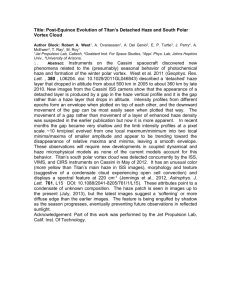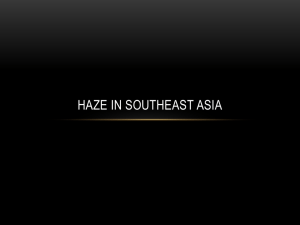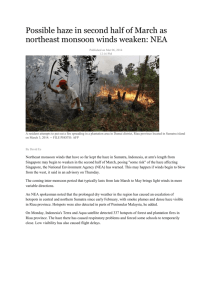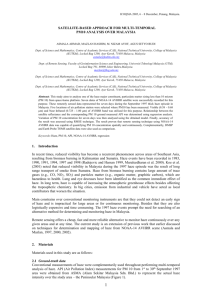DETERMINATION OF HAZE USING NOAA-14 AVHRR SATELLITE DATA
advertisement
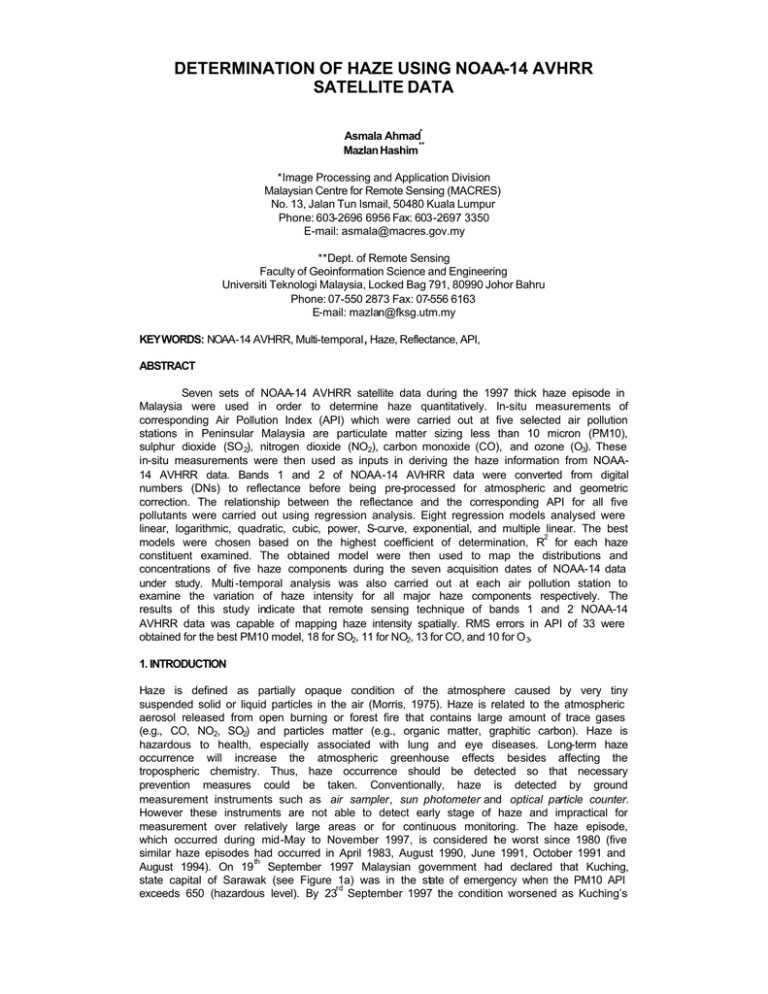
DETERMINATION OF HAZE USING NOAA-14 AVHRR SATELLITE DATA Asmala Ahmad* ** Mazlan Hashim *Image Processing and Application Division Malaysian Centre for Remote Sensing (MACRES) No. 13, Jalan Tun Ismail, 50480 Kuala Lumpur Phone: 603-2696 6956 Fax: 603-2697 3350 E-mail: asmala@macres.gov.my **Dept. of Remote Sensing Faculty of Geoinformation Science and Engineering Universiti Teknologi Malaysia, Locked Bag 791, 80990 Johor Bahru Phone: 07-550 2873 Fax: 07-556 6163 E-mail: mazlan@fksg.utm.my KEY WORDS: NOAA-14 AVHRR, Multi-temporal, Haze, Reflectance, API, ABSTRACT Seven sets of NOAA-14 AVHRR satellite data during the 1997 thick haze episode in Malaysia were used in order to determine haze quantitatively. In-situ measurements of corresponding Air Pollution Index (API) which were carried out at five selected air pollution stations in Peninsular Malaysia are particulate matter sizing less than 10 micron (PM10), sulphur dioxide (SO 2), nitrogen dioxide (NO2), carbon monoxide (CO), and ozone (O3). These in-situ measurements were then used as inputs in deriving the haze information from NOAA14 AVHRR data. Bands 1 and 2 of NOAA-14 AVHRR data were converted from digital numbers (DNs) to reflectance before being pre-processed for atmospheric and geometric correction. The relationship between the reflectance and the corresponding API for all five pollutants were carried out using regression analysis. Eight regression models analysed were linear, logarithmic, quadratic, cubic, power, S-curve, exponential, and multiple linear. The best 2 models were chosen based on the highest coefficient of determination, R for each haze constituent examined. The obtained model were then used to map the distributions and concentrations of five haze components during the seven acquisition dates of NOAA-14 data under study. Multi -temporal analysis was also carried out at each air pollution station to examine the variation of haze intensity for all major haze components respectively. The results of this study indicate that remote sensing technique of bands 1 and 2 NOAA-14 AVHRR data was capable of mapping haze intensity spatially. RMS errors in API of 33 were obtained for the best PM10 model, 18 for SO2, 11 for NO2, 13 for CO, and 10 for O 3. 1. INTRODUCTION Haze is defined as partially opaque condition of the atmosphere caused by very tiny suspended solid or liquid particles in the air (Morris, 1975). Haze is related to the atmospheric aerosol released from open burning or forest fire that contains large amount of trace gases (e.g., CO, NO2, SO2) and particles matter (e.g., organic matter, graphitic carbon). Haze is hazardous to health, especially associated with lung and eye diseases. Long-term haze occurrence will increase the atmospheric greenhouse effects besides affecting the tropospheric chemistry. Thus, haze occurrence should be detected so that necessary prevention measures could be taken. Conventionally, haze is detected by ground measurement instruments such as air sampler, sun photometer and optical particle counter. However these instruments are not able to detect early stage of haze and impractical for measurement over relatively large areas or for continuous monitoring. The haze episode, which occurred during mid-May to November 1997, is considered the worst since 1980 (five similar haze episodes had occurred in April 1983, August 1990, June 1991, October 1991 and th August 1994). On 19 September 1997 Malaysian government had declared that Kuching, state capital of Sarawak (see Figure 1a) was in the state of emergency when the PM10 API rd exceeds 650 (hazardous level). By 23 September 1997 the condition worsened as Kuching’s PM10 API reached 839, the highest ever been recorded by the country. Meteorologist had revealed that it was due to the injection of suspended ash particles from large-scale forest fire in Sumatra and Kalimantan. In addition, the occurrence of shallow localized haze in big cities (e.g., Kuala Lumpur, Kelang, Johor Bahru) caused mainly by vehicle and industrial emissions which were stimulated by the South West Monsoon Season which acted as the minor contributor that made the condition worse. Such phenomenon (which is not a new experience for Malaysia) has created awareness among the people concerning the haze problem and more commitments are put to curb haze occurrence effectively. This paper reports the results of a study, which was carried out to quantify haze from NOAA-14 AVHRR data, and their spatial distribution based on local API. Final results were presented as maps of haze-intensity for individual haze components namely, PM10, CO, SO2 and NO2. 2. MATERIALS AND METHODS 2.1 Satellite Data The multi-temporal datasets of NOAA-14 AVHRR satellite dated 22, 23, 25, 26, 28, 29 and 30 September 1997 were used in this study. The data were subseted to the area of interest - the Peninsular Malaysia (see Figure 1a). 2.2 Air Pollution Index (API) The measured API of major haze components namely PM10, CO, NO2, SO2 and O3 used in this study are provided from ASMA (Alam Sekitar Malaysia Sdn Bhd.), agency contracted by the Department of Environment Malaysia to measure air quality throughout the country. The local API values were measured at selected five air pollution stations (see Figure 1b) for all the seven satellite acquisition dates. Malaysian Air Pollution Index (API) was formulated based on the United States Pollutant Standard Index (PSI). The only difference is that the Malaysian cut-off point is 100; i.e. 100 represents the maximum limit of acceptable air quality standard for Malaysia. The PSI has been developed by the Environment Protection Agency (EPA) to provide accurate, timely and easily understandable information about daily levels of air pollution. The EPA uses the PSI to measure five major pollutants for which it has established National Ambient Air Quality Standard under the USA Clean Air Act (EPA, 1970). The pollutants are particulate matter (soot, dust, and particle), sulphur dioxide, carbon monoxide, nitrogen dioxide and ozone. 3 DATA PRE-PROCESSING Raw NOAA-14 AVHRR data appears in DN (digital number). To prepare for further data processing, the raw AVHRR data were converted from DN to reflectance band 1, 2 and brightness temperature for band 3, 4 and 5 respectively. However, in this study, only band 1 and 2 of NOAA-14 AVHRR were converted to reflectance for haze information extraction. 3.1 Calibration of NOAA-14 AVHRR data NOAA-14 AVHRR data calibrations were carried out based on procedures described by Kidwell (1995). The calibration coefficients based on the post-launch calibration procedures by Rao and Chen (1996) were used for this purpose. 3.2 Atmospheric Correction Atmospheric Correction algorithm based on Jensen (1996) was used to minimise unwanted atmospheric effects. Atmospheric transmittance were generated using LOWTRAN model (Kneizys et al.,1989). 3.3 Geometric Correction The NOAA-14 AVHRR data is rectified using image to map approach. In this study the coastline of area of interest (Peninsular Malaysia) were digitised into the digital image processing system in which the image was registered. Final rectified image was resampled using nearest neighbour scheme to retain the original radiometric value of the corrected datasets. Geometric accuracy of the new rectified data was determined by tolerating an RMSE (root mean square error) of less than 0.5 pixel. 4. DATA PROCESSING All image processing tasks were carried out using PCI EASI/PACE digital image processing system at the Centre for Remote Sensing, University of Technology Malaysia. Presumption made in this study was that each API measurement represents a locus of 2.75 km-radius around each of the air pollution stations. A computer program was also developed to discriminate clouds from haze and to produce haze-intensity maps of major individual components that formed the haze. B E A D C (a) Station A. Kuala Lumpur, Wilayah Persekutuan B. Prai, Penang C. Pasir Gudang, Johor D. Bukit Rambai, Melaka E. Bukit Kuang, Terengganu (b) Figure 1 : (a) Study area (shaded), and (b) Combination of band 1, 2 and 4 of NOAA-14 AVHRR data dated 22 September 1997. Location of the selected air pollution stations are damarcated as letter A,B,C,D and E designated for Kuala Lumpur, Prai, Pasir Gudang, Bukit Rambai, and Bukit Kuang respectively. Combination of band 1, 2 and 4 are used to visually differentiate between haze (orange), low clouds (yellow) and high clouds (white). 4.1 Discrimination between Haze and Clouds AVHRR band 1 reflectance are used to discriminate cloud and haze. A simple procedure described by Baum (1997) was implemented, which stated that haze and cloud pixels show reflectance below 0.45 and above 0.55, respectively. (a) (b) Figure 2 : Band 1 NOAA-14 AVHRR in percent reflectance (a) and clouds masking (b). 4.2 Derivation of Haze Model This study was conducted based on a model developed by Siegenthaler and Baumgartner (1996), which make use of skylight to indicate the existence of haze. Skylight is an indirect radiation, which occurs when radiation from the sun being scattered by elements within the haze layer. It is not a direct radiation, which is dominated by pixels on the earth surface. Figure 3 shows electromagnetic radiation path propagating from the sun towards the NOAA-14 AVHRR satellite penetrating through a haze layer. Path number 1, 3 and 4 are skylight caused by direct radiation, whereas path 2 is indirect radiation. NOAA-14 AVHRR Sun Incoming radiation from the sun Radiation reflected towards sensor 1 2 3 4 1000 Altitude Haze layer 0m Pixel Earth surface (Source : Modified after Siegenthaler and Baumgartner, 1996) Figure 3 : the skylight parameter model The model is described by: σ- R = L – V …(1.0) where: σ : reflectance recorded by satellite sensor (indirect radiation), R : reflectance from known object from earth surface (direct radiation), L : skylight, and V : lost radiation caused by scattering and absorption. 4.3 Regression Analysis The relationship between ground-truth measurements of haze API and satellite recorded reflectance of band 1 and 2 AVHRR, were shown as the best regression models for individual haze components namely, PM10, carbon monoxide (CO), sulphur dioxide (SO ), nitrogen dioxide (NO ), and ozone (O ). 2 2 3 These are shown in Table 1. 4.4 Generation of Haze Intensity Map Finally, these models were used in generating maps of haze individual components intensity for prediction of haze API from NOAA-14 AVHRR data. 4.5 Accuracy Analysis of Haze Intensity Map Accuracy analysis of the haze intensity map was carried out using Root-mean-squared error (RMSE) technique. Table 1 : Models used in generating the haze intensity maps and corresponding RMSE 2 Haze R Regression Model RMSE Compone (API) Equation Type nt PM10 0.509 2 PM10 = -0.2410*(Band 1) +0.007*(Band Cubic 33 SO2 = 4.7528*Band 1-0.0004*(Band 1) -112.7823 Cubic 18 NO2 = -0.1849*(Band 2)2+0.0049*(Band Cubic 11 Power 13 Quadrati 10 3 8 SO2 0.315 1) +108.3328 3 4 NO2 0.326 3 2 CO 0.242 2) +39.5779 CO = 0.0005*(Band 2) 3.1026 8 O3 0.028 2 O3 = 4.0242*(Band 1)-0.0642*(Band 1) -15.2524 6 c 5. RESULTS AND DISCUSSION Results of the best regression models for each of the haze constituents with band 1 of NOAA-14 AVHRR data were shown in Table 1. The final haze intensity maps generated from best regressed models for 2 each constituent were shown in figure 5(a), 5(b), 5(c), 5(d) and 5(e). The best R is exhibited by PM10 while relatively average relationship in the case of SO2 and NO2. CO and O3 have weak relationship with reflectance. Limited numbers of in-situ air pollution station measurement has been identified as the main factor that hinders better result. 6. CONCLUSION The relationship using NOAA-14 AVHRR (band 1 and 2) and API of haze constituents data has been examined. Best model, which was exhibited by PM10. SO2. NO2, CO and O3 showed average to weak relationship. The study is currently being continued with additional air station input for establishment of better and more meaningful relationship 7. REFERENCES 1. Baum, B.A. (1997). “Discrimination between clouds and smoke/fires in daytime AVHRR data.” NASA Langley Research Center Atmospheric Sciences Division Radiation Sciences Branch Homepage [Online] Available, http://asd-www.larc.nasa.gov/~baum/Pathfinder/smoke.html. 2. EPA (1970). The Clean Air Act (CAA). Washinton D.C. : EPA. 3. Jensen, J.R. (1996). Introductory Digital Image Processing. Prentice Hall, New Jersey 4. Kidwell, K. B., comp. and ed., 1995, NOAA-14 Polar Orbiter Data (TIROS-N, NOAA-14-6, NOAA14-7, NOAA-14-8, NOAA-14-9, NOAA-14-10, NOAA-14-11, NOAA-14-12, and NOAA-14) Users Guide: Washington, D.C., NOAA-14/NESDIS. 5. PCI Inc. (1997). PCI EASI/PACE Manual, Version 6.1. Ontario, Canada : PCI Inc. 6. Kneizys, F.X., Shettle, E.P., Gallery, W.O., Chetwynd, J.H., Abren, L.W., Selby, J.E.A., Clough, S.A. and Fern, R.M. (1989). Atmospheric Transmittance/Radiance: Computer Code LOWTRAN 7. Hanscom Air Base, Massachusetts : U.S. Air Force Geophysical Laboratory. 7. Rao, C.R.N. and Chen, J. (1996), “Post-launch calibration of the visible and near-infrared channels of the Advanced Very High Resolution Radiometer on the NOAA-14 spacecraft” International Journal of Remote Sensing, 17, pp. 2743-2747. 8. Siegenthaler, R., and Baumgartner, M.F. (1996). “Haze and Miss Phenomena in the Swiss Lowlands – Analysed with Spaceborne (NOAA-14 AVHRR) and Airborne (Imaging Spectrometry) Data” dalam Parlow, E. “Progress in Environmental Remote Sensing Research and Application.” pp. 453-459. U U T a n p a Skala T a n p a Skala B B E E A A D D C C PM10(API) 0 (Clouds) 151-200 1-50 201-250 51-100 251-300 101-150 Figure 5(a) : Intensity map of PM 10.on the 26th September 1997 (7.29 GMT) CO (API) 0 (Clouds) 16-20 1-5 6-10 21-25 26-30 11-15 31-35 Figure 5(b) : Intensity map of CO on 22nd September 1997 (8.31 GMT) U U T a n p a Skala T a n p a B Skala B E E A A D D C C NO 2 (API) SO2 (API) 0 (Clouds) 11-15 0 (Clouds) 16- 20 1-5 16-20 1-5 21- 25 6-10 21-25 6-10 26- 30 11-15 Figure 5(c) : Intensity map of SO2 on the 29th September 1997 (6.55 GMT) U T a n p a Skala B E A D C O 3 (API) 0 (Clouds) 21-30 1-10 31-40 11-20 41-50 Figure 5(e) : Intensity map of O3 on the 25th September 1997 (7.40 GMT) Figure 5(d) : Intensity map of NO 2 on the 22nd September 1997 (8.31 GMT)


